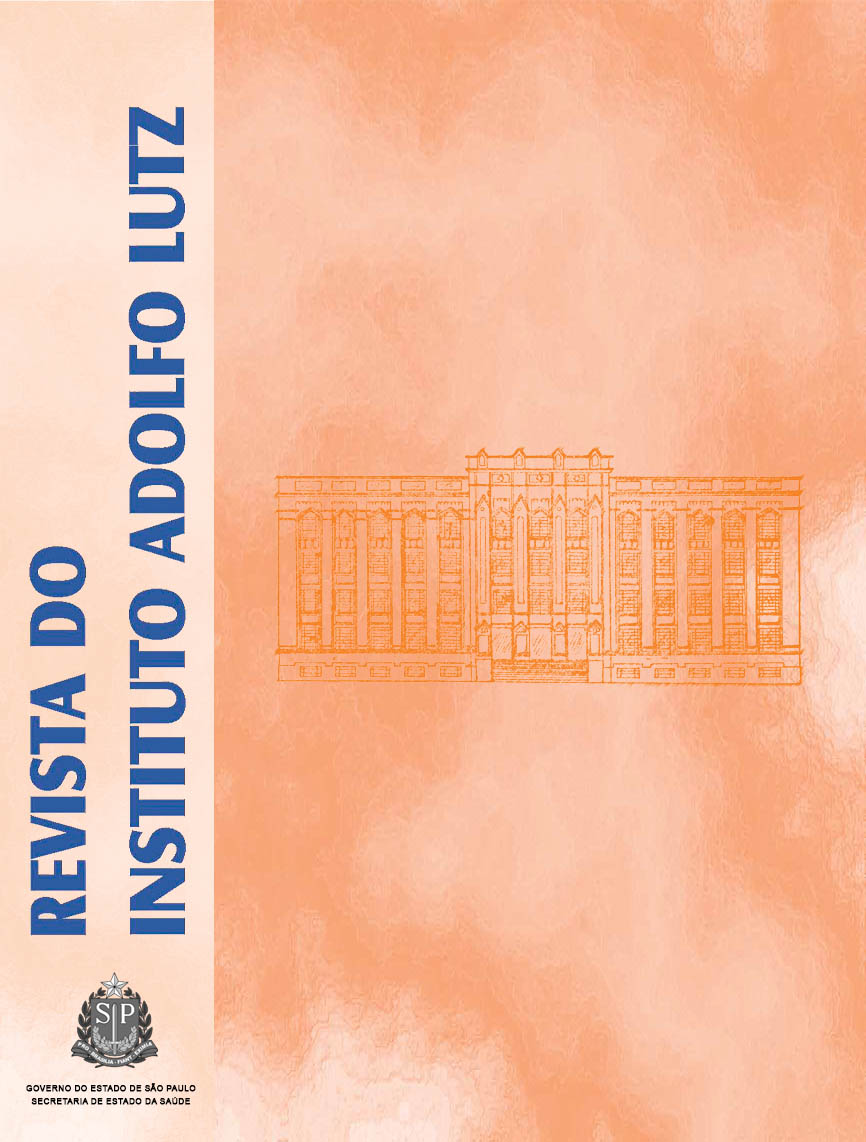Abstract
The hygienic conditions in preparing the infant milk formula used in a public hospital milk dispensary were investigated by microbiological analyses of air, equipment, utensils, powdered and reconstituted infant dairy formula (IDF). Samples were collected from 10 different sampling points of six preparation batches. A total of 60 samples were analyzed for identifying and quantifying the indicative microorganisms as fecal coliforms, total Enterobacteriaceae, aerobic mesophilic and psycrotrophic microorganisms and pathogenic microorganisms as coagulase-positive Staplylococcus, Bacillus cereus and Salmonella. A high variation in the indicative microorganisms counting was observed, although no pathogenic agent was detected. All of the powdered IDF samples were appropriate for consumption according to the regulatory standard. However, the reconstituted IDF samples showed high counts of the majority of indicative microorganisms. Also, this study identified the blender as the main source for reconstituted IDF contamination, and from which the total Enterobacteriaceae and total aerobic mesophilic microorganisms were isolated. Non-compliance with the hygienic prerequisites during the preparation of the reconstituted IDF resulted in an inadequate l product for children consumption.References
1. Centro de Vigilância Epidemiológica “Prof. Alexandre Vranjac”. Vigilância ativa das doenças transmitidas por alimentos – Normas e instruções. São Paulo: Centro de Vigilância Epidemiológica; 2002.
2. Agência Nacional de Vigilância Sanitária (ANVISA). Pediatria: Prevenção e controle de infecção hospitalar. Brasília: Editora Anvisa; 2006.
3. Mezomo IF. Serviço de nutrição e dietética. São Paulo: União Social Camiliana; 1987. Lactário; p.115-37.
4.Santos RFS. Ocorrência de Enterobacter sakazakii em fórmulas infantis para lactentes em hospitais e maternidades da região de Campinas/SP [dissertação de Mestrado]. Campinas: Universidade Estadual de Campinas – Faculdade de Engenharia de Alimentos; 2006.
5. American Public Health Association (APHA). Compendium of Methods for the Microbiological Examination of foods. 3ªed. Washington: APHA; 1992.
6. International Commission on Microbiological Specifications for Foods (ICMSF). Microorganisms in Food. 6 v. Maryland: Aspen Publishers; 2000. Microbial Ecology of food commodities; p.541-44.
7. Van Acker J et al. Outbreak of necrotizing enterocolitis associated with Enterobacter sakazakii in powdered milk formula. J Clin Microbiol. 2001; 39: 293-7.
8. Iversen C and Forsythe S. Isolation of Enterobacter sakazakii and other Enterobacteriaceae from powdered infant formula milk and related products. Food Microbiol. 2004; 21: 771-7.
9. Comunidade Europeia (CE). Regulamento Nº 2073/2005 de 15 de Novembro de 2005, Critérios microbiológicos aplicáveis aos gêneros alimentícios. Jornal Oficial [da] União Europeia. [acesso em 22 dez.2005]. Disponível em [http://eur-lex.europa.eu/JOYear.do?year=2005]. Data de acesso: 25/03/2007.
10. Evancho GM, Sveum WH, Moberg LJ, Frank JF. Microbiological Monitoring of the Food Processing Enviroment. In: APHA (American Public Health Association). Compendium of Methods for the Microbiological Examination of Foods. 4 ed. Washington: APHA; 2001. p.25-36.
11. Morton RD. Aerobic Plate Count. In: APHA (American Public Health Association). Compendium of Methods for the Microbiological Examination of Foods. 4 ed. Washington: APHA; 2001. p. 63-8.
12. Kornacki JL, Johnson JL. Enterobacteriaceae, Coliforms, and Escherichia coli as Quality and Safety Indicators. In: APHA (American Public Health Association). Compendium of Methods for the Microbiological Examination of Foods. 4ª ed. Washington: APHA; 2001. p. 69-82.
13. Bennett RW, Belay N. Bacillus cereus. In:APHA (American Public Health Association). Compendium of Methods for the Microbiological Examination of Foods. 4ª ed. Washington: APHA; 2001. p. 311-6.
14. Silva N, Junqueira VCA, Silveira NFA. Manual de métodos de Análise Microbiológica de Alimentos. São Paulo: Varela; 1997, p.53-8.
15. Andrews HW, Flowers RS, Silikers J, Bailey SJ. Salmonella. In: APHA (American Public Health Association). Compendium of Methods for the Microbiological Examination of Foods. 4ª ed. Washington: APHA; 2001. p. 357-80.
16. Brasil. Agência Nacional de Vigilância Sanitária (ANVISA). Resolução RDC nº12, de 2 de janeiro de 2001. Regulamento Técnico sobre Padrões Microbiológicos para Alimentos. Diário Oficial [da] União. Brasília, DF, 2 jan 2001. Seção 1.
17. Salles RK, Goulart R. Diagnóstico das condições higiênico-sanitárias e microbiológicas de lactários hospitalares. Rev Saúde Pública. 1997; 31(2):131-9.
18. Muniz CK. Análise de Perigos e Pontos Críticos de Controle em dietas enterais manipuladas em Hospital Universitário Público do Brasil [dissertação de Mestrado]. Uberlândia: Biblioteca Digital da Universidade Federal de Uberlândia; 2005.
19. Almeida RCC, Matos CO, Almeida PF. Implementation of a HACCP system for on-site hospital preparation of infant formula. Food Control. 1999; 10; 181-97.
20. U.S. Department of Health and Human Service food and Drug Administration (FDA). Compliance Program Guidance Manual. EUA. 2006, 31. Food Composition, Standards, Labeling and Economics.31 July 2006.
21. Brasil. Agência Nacional de Vigilância Sanitária (ANVISA). Resolução RDC nº216 de 15 de setembro de 2004. Regulamento Técnico de Boas Práticas para Serviços de Alimentação. Diário Oficial [da] União. Brasília, DF, 16 set 2004. Seção 1.
22. Franco BDGM, Landgraf M. Microbiologia dos Alimentos. São Paulo: Atheneu; 2008, p.28
23. Estuningsih S, Kress C, Hassan AA, Akineden O, Schneider E, Usleber E. Enterobacteriaceae in dehydrated powdered infant formula manufactured in Indonesia and Malaysia. J Food Prot. 2006; 69(12): 3013-17.
24. Bar-Oz B, Preminger A, Peleg O, Block C, Arad I. Enterobacter sakazakii infection in the newborn. Acta Paediatr. 2001; 90(3): 356-8.
25. Shaker R, Osaili T, Al-Omary W, Jaradat Z, Mahmoud A. Isolation of Enterobacter sakazakii and other Enterobacter ssp from food and food production environments. Food Control. 2007; 18(10): 1241-5.
26. Sanders WEJ, Sanders CC. Enterobacter ssp.: Pathogens Poised to Flourish at the Turn of the Century. Clin Microbiology Rev. 1997; 10(2): 220-41.
27. Talon D, Menget P, Thouverez M, Thiriez G, Gbaguidi HH, Fromentin C et al. Emergence of Enterobacter cloacae as a common pathogen in neonatal units: pulsed-field gel electrophoresis analysis. J Hosp Infect. 2004; 57(2): 119-25.
28. Kuboyama RH, Oliveira HB, Moretti-Branchini ML. Molecular epidemiology of systemic infection caused by Enterobacter cloacae in a righ-risk neonatal intensive care unit. Infect Control Hosp Epidemiol. 2003; 24(7): 490-94.
29. Rowan NJ, Anderson JG, Anderton A. Bacteriological quality of infant milk formulae examined under a variety of preparation and storage conditions. J Food Prot. 1997; 60(9). 1089-94.

This work is licensed under a Creative Commons Attribution 4.0 International License.
Copyright (c) 2010 Instituto Adolfo Lutz Journal
